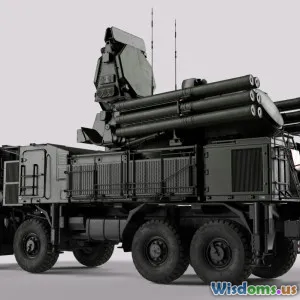
Are Magnetic Bombs the Future of Urban Warfare
10 min read Exploring the role magnetic bombs could play in urban warfare's evolving landscape and their strategic implications. (0 Reviews)
Are Magnetic Bombs the Future of Urban Warfare?
Urban warfare has historically been one of the most complex and demanding forms of combat, requiring new strategies, technologies, and weaponry to address the densely built environments where forces and civilians coexist closely. One emerging technology that sparks both intrigue and debate is the magnetic bomb — a weapon designed to leverage magnetism to adhere to metallic surfaces, enabling precise targeting and devastating effects.
In this comprehensive analysis, we will explore the development, mechanism, tactical advantages, and the potential future role of magnetic bombs in urban warfare contexts.
Introduction: The Challenge of Combat in Cities
The shifts in global conflict over recent decades highlight urban battlefields as central hotspots. According to the United Nations, over 55% of the world's population now lives in urban areas, growing steadily. Cities offer both strategic advantages and escalate risks for combat operations, including civilian casualties, structural damage, and complex enemy concealment.
Traditional explosives and missile technologies often lack the ability to discriminate individual threats effectively within urban clutter, leading to collateral damage. Enter magnetic bombs: weapons designed to attach directly onto metallic surfaces such as vehicles, infrastructure, or adversary equipment to maximize impact precisely where it counts.
What Are Magnetic Bombs?
Magnetic bombs, sometimes referred to as mag bombs or magnetically adherent explosive devices, are specialized ordnance enabled with powerful magnets that adhere to metallic targets upon delivery.
Design and Technology
Typically, these bombs incorporate electromagnets or permanent magnets such as neodymium variants arranged to produce strong adhesion to ferromagnetic materials. The design may include remote detonation mechanisms, timers, or impact triggers.
For example, a refined mag bomb deployed from drones can hover near a target vehicle's chassis, stick magnetically beneath it, and detonate, disabling critical components or causing an explosion tailored to the target's weaknesses. Unlike widespread area-effect weapons, magnetic bombs emphasize precision and minimizing unintended damage.
Real-World Precedents
In the 1970s and 80s, urban guerilla factions and intelligence units experimented with similar concepts called 'sticky bombs' — explosives coated with adhesives to deliver blasts through attachment. Today’s magnetic bombs advance this principle with technology perfected for dynamic, modern combat situations.
Modern military programs, such as those reported in recent years by defense contractors in the U.S. and Russia, suggest ongoing research into magnetic explosives for sophisticated urban combat operations, though detailed public specifications are scarce.
Tactical Advantages in Urban Environments
Utilizing magnetic bombs could transform urban warfare by addressing key challenges: precision targeting, minimized collateral damage, and new assault possibilities.
Precision Attachment to Moving Targets
Urban combat is characterized by numerous metallic surfaces—vehicles, infrastructure reinforcements, armored doors, and network equipment. Magnetic bombs can adhere to these moving elements, such as armored personnel carriers or supply trucks, allowing forces to neutralize high-value targets discreetly.
For instance, battlefield drone operators could remotely deliver a magnetic bomb to an enemy convoy traveling narrow city streets, attach the device precisely, and detonate when the unit is vulnerable. This capability reduces the chance of explosive dispersal affecting nearby structures or civilians.
Reduction of Collateral Damage
According to the RAND corporation, one of the most significant barriers in urban warfighting is civilian casualty avoidance and the protection of critical infrastructure. Magnetic bombs' targeted destructive power could minimize explosive scopes, thus aligning with international humanitarian law standards.
Military experts advocate that smaller, more accurate charges can disrupt enemy capabilities while preserving essential urban functions like power lines and water systems.
Adaptability and Covert Operations
Due to their smaller size and magnetic securing mechanism, such bombs could be employed in covert sabotage operations or asymmetric warfare tactics. For example, special forces could deploy magnetic explosives inside dense city blocks to discreetly disable enemy equipment during a night raid.
Limitations and Challenges
Despite the promising potential, magnetic bombs come with technical and strategic hurdles that require consideration.
Dependence on Metal Surfaces
Magnetic bombs require ferromagnetic surfaces for attachment, limiting their usage against purely non-metallic targets such as concrete barriers or human personnel. In cities heavily fortified with composite or non-metallic materials, their effectiveness diminishes.
Risk of Defeat by Countermeasures
Adversary forces could develop countermeasures such as electromagnetically shielded vehicles or remote neutralization tools (e.g., electronic jamming) to reduce magnetic bombs' success. Awareness of these developments would drive continuous innovation but can delay practical deployment.
Ethical and Legal Concerns
The precision of magnetic bombs provides advantages but also raises concerns about clandestine placements in civilian contexts, possibly blurring lines between terrorism and military engagement. Robust rules of engagement and strict operational protocols will be vital to lawful use.
Innovations Complementing Magnetic Bombs
Magnetic bombs do not exist in isolation; their future lies intertwined with several advancing technologies:
Autonomous Delivery Systems
The fusion of magnetic bombs with autonomous drones capable of precise urban maneuvering expedites rapid deployment. For example, companies like AeroVironment and DJI have developed drones adaptable for military payloads. Coupling magnetic bombs with AI-guided drones enhances operational flexibility.
Enhanced Sensor Integration
Sensors capable of identifying metallic weaknesses or electromagnetic signatures can allow magnetic bombs to attach optimally — maximizing damage. Advances in embedded AI and real-time data processing would play decisive roles.
Network-Centric Warfare
Internet-connected devices allow soldiers and command centers to track magnetic bomb status or pre-arrange detonation remotely, facilitating synchronized operations on urban battlefields where rapid decision cycles dominate.
Case Studies and Hypotheticals
While direct large-scale deployment of magnetic bombs remains limited publicly, hypothetical scenarios highlight potential impacts.
Hypothetical Scenario: Disabling Enemy Vehicles in Narrow Urban Alleyways
A military unit faces armored convoys threatening a strategic city district. Using high-speed drones equipped with magnetic bombs, soldiers attach charges to vehicles when the convoy slows in constricted alleys, disabling the vehicles and neutralizing threats swiftly, without destroying nearby buildings.
Lessons from Past Conflicts
During the Battle of Mosul (2016-2017), urban warfare challenged coalition forces with intense close quarters fighting. While primarily reliant on traditional explosives and sniper tactics, future application of magnetic bombs with drone delivery might have improved vehicle neutralization methods, preserving structural integrity and reducing civilian harm.
The Ethical Imperative: Balancing Innovation and Humanitarian Responsibility
As with all military technologies, the adoption of magnetic bombs comes with a profound ethical obligation. Their precision aligns with desires to reduce civilian casualties, yet misuse or clandestine use can exacerbate urban tensions and civilian suffering.
International law experts stress the importance of transparency, controlled deployment, and accountability mechanisms to govern magnetic bomb use.
Conclusion: A Technological Frontier Shaping Urban Combat
Magnetic bombs represent a potential breakthrough in urban combat arsenals, offering precision, minimized collateral damage, and new tactical options. While challenges remain, ongoing technological advancements and integration with drones and AI suggest magnetic bombs could fundamentally shift how militaries engage in dense, complex urban theaters.
Ultimately, the future of magnetic bombs in urban warfare hinges not only on engineering success but also on ethical deployment, adversary adaptation, and strategic doctrine evolutions that collectively define modern conflict landscapes.
As urban warfare grows in prominence and complexity, magnetic bombs stand as one of many innovative tools that could make fighting smarter, not just fiercer.
Author’s Note: Continued research and open debate are essential to understand the full implications of magnetic bomb technology in urban combat scenarios, balancing military necessity and humanitarian considerations.
Rate the Post
User Reviews
Other posts in Explosives and Ordnance
Popular Posts
















